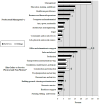Occupational outcomes of adult childhood cancer survivors: A report from the childhood cancer survivor study
- PMID: 21246530
- PMCID: PMC3547616
- DOI: 10.1002/cncr.25867
Occupational outcomes of adult childhood cancer survivors: A report from the childhood cancer survivor study
Abstract
Background: The authors examined whether survivors from the Childhood Cancer Survivor Study were less likely to be in higher-skill occupations than a sibling comparison and whether certain survivors were at higher risk for lower-skill jobs.
Methods: The authors created 3 mutually exclusive occupational categories for participants aged ≥ 25 years: Managerial/Professional, Nonphysical Service/Blue Collar, and Physical Service/Blue Collar. The authors examined currently employed survivors (4845) and their siblings (1727) in multivariable generalized linear models to evaluate the likelihood of being in 1 of the 3 occupational categories. Multinomial logistic regression was used among all participants to examine the likelihood of these outcomes compared to being unemployed (survivors, 6671; siblings, 2129). Multivariable linear models were used to assess survivor occupational differences by cancer- and treatment-related variables. Personal income was compared by occupation.
Results: Employed survivors were less often in higher-skilled Managerial/Professional occupations (relative risk, 0.93; 95% confidence interval 0.89-0.98) than their siblings. Survivors who were black, were diagnosed at a younger age, or had high-dose cranial radiation were less likely to hold Managerial/Professional occupations than other survivors. In multinomial models, female survivors' likelihood of being in full-time Managerial/Professional occupations (27%) was lower than male survivors (42%) and female (41%) and male (50%) siblings. Survivors' personal income was lower than siblings within each of the 3 occupational categories in models adjusted for sociodemographic variables.
Conclusions: Adult childhood cancer survivors are employed in lower-skill jobs than siblings. Survivors with certain treatment histories are at higher risk for lower-skill jobs and may require vocational assistance throughout adulthood.
Copyright © 2011 American Cancer Society.
Figures



References
-
- Mariotto AB, Rowland JH, Yabroff KR, et al. Long-Term Survivors of Childhood Cancers in the United States. Cancer Epidemiol Biomarkers Prev. 2009 Apr;18(4):1033–1040. - PubMed
-
- Ries LAG, Smith MA, Gurney JG, Linet M, Tamra T, Young JLBG, editors. Institute NC. Cancer incidence and survival among children and adolescents: United States SEER Program 1975–1995. Bethesda, MD: National Institutes of Health; 1999. No. NIH Pub. No. 99–4649.
Publication types
MeSH terms
Grants and funding
LinkOut - more resources
Full Text Sources
Medical

